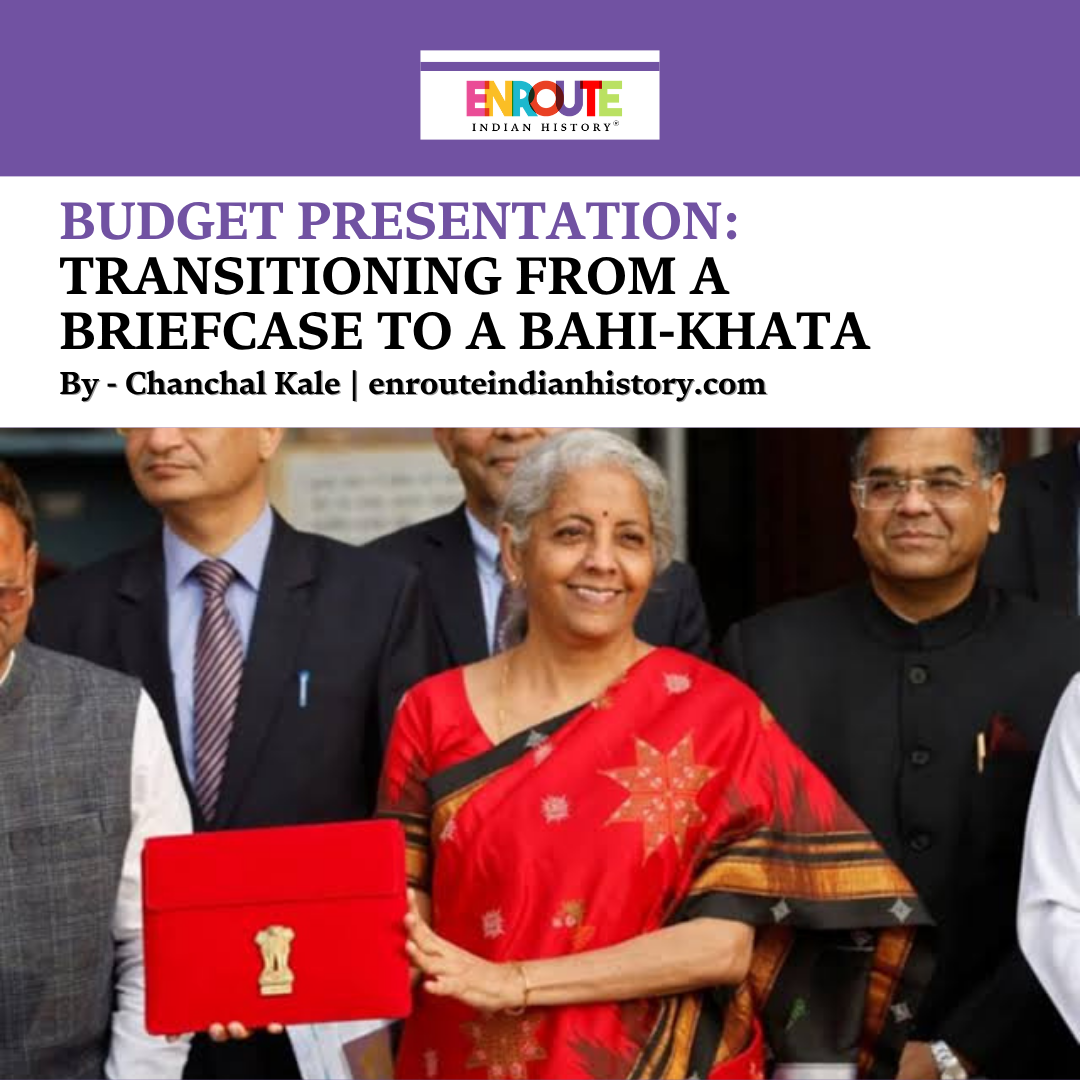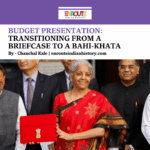Budget Presentation: Transitioning from a Briefcase to a Bahi-Khata
- iamanoushkajain
- June 2, 2025

By Chanchal Kale
The practice of the finance minister presenting the annual budget while carrying a red leather briefcase has become emblematic of India’s fiscal discourse. This briefcase, though modest in size, symbolizes the substantial responsibility of managing the nation’s economic trajectory. Its
origins can be traced back to colonial traditions that dictated the carrying of leather cases during budget presentations. However, in 2019, Finance Minister Nirmala Sitharaman broke from this historical precedent by opting for a Bahi-Khata—a traditional Indian pouch— to present the budget documents. This choice not only reflects a departure from colonial influences but also pays homage to age-old Indian methods of record-keeping, signalling a renewed emphasis on Indigenous practices in contemporary governance.
Association of the Briefcase with the Budget
The word ‘Budget’ has an Intriguing origin, tracing back to the French term ‘Bougette,’ which translates to a small leather bag or suitcase. In the 15 th century, travellers used these bags to carry their small goods, making the concept of managing resources quite literal! The term made its
way into English and was famously incorporated by William Shakespeare in his play “The Winter’s Tale,” where he wrote, “If tinkers may have leave to live, And bear the sow-skin budget, Then my account I well may give, And in the stocks avouch it.” This gave rise to the phrase “open your budget,” meaning to reveal what you possess. Over the years, the term evolved, coming to signify a collection of important documents. The first financial use of “Budget” emerged in 1733. It was famously used in a satirical pamphlet titled “The Bouget Opened,” which critiqued the tax plans of British minister Sir Robert Walpole. Gradually, “Budget” began to embody the tax proposals themselves, shaping how we view financial planning today.
The iconic red briefcase associated with budgets has a rich history in British politics. A fascinating anecdote tells of Queen Elizabeth I’s representatives presenting a red briefcase filled with black puddings to the Spanish ambassador in the 16 th century. This was a bold statement amidst the tense relations fuelled by England’s maritime ambitions clashing with Spain’s colonial dominance. Yet another tale suggests that Prince Albert favoured red because it matched the coat of arms of his house, Saxe-Coburg-Gotha. Most research, however, points to 1860 as the pivotal year when British Chancellor William E. Gladstone introduced a striking red leather briefcase, adorned with the Queen’s monogram in gold, famously known as the Gladstone Box. The colour red, known for attracting attention, was a fitting choice for such significant announcements.
This tradition soon found its way to India during British colonization in the 19 th century. However, the ritual of showcasing the budget bag before the speech became a custom only after independence. India’s first budget, delivered by Finance Minister R.K. Shanmukham Chetty on November 26, 1947, made headlines nationwide, along with the photographs capturing him with his leather portfolio filled with budget papers. This moment marked the beginning of a beloved tradition where each finance minister poses with the budget bag before presenting the annual budget, cementing its significance in Indian financial history.
Over the years, India’s finance ministers have added a splash of colour and creativity to the traditionally red budget briefcase, known as the Gladstone box, which has been a staple in British finance since 1860. It all began in 1958 when India’s first prime minister, Jawaharlal Nehru, broke from convention by arriving with a sleek black briefcase instead of the usual vibrant hue.
Fast forward to 1991, a pivotal year in India’s economic history. Former prime minister Manmohan Singh made waves with his bold black bag as he unveiled the iconic economic liberalization proposals. Then, in 1998-99, finance minister Yashwant Sinha surprised everyone with a unique leather bag adorned with straps and buckles, steering away from the age-old tradition.
Pranab Mukherjee, serving under Manmohan Singh, opted for a red briefcase reminiscent of its British counterpart, keeping the classic flair alive. However, it was Piyush Goyal, who presented the interim budget in February 2019, that marked the end of an era by being the last finance
minister to carry a briefcase in the traditional sense.
In a remarkable shift, Finance Minister Nirmala Sitharaman introduced a vibrant Bahi-Khata during her maiden budget presentation in 2019, showcasing budget papers in a nod to India’s heritage. In a moment of true innovation, she declared that the Bahi-Khata—a traditional Indian
ledger—was a departure from colonial practices, celebrating the pride of Indian culture.
Historic and cultural significance of Bahi-Khata
In ancient India, temples functioned not only as religious institutions but also as significant economic entities, managing extensive landholdings and receiving substantial donations. Their operations encompassed various sectors, including agriculture, trade, education, and social welfare, necessitating a sophisticated system of record-keeping to ensure efficiency and transparency. To facilitate this, records were traditionally stored in red pouches secured with jute ropes. The choice of red, a colour imbued with religious significance in Hinduism, underscored the sanctity of these records.
As economic systems evolved and grew increasingly complex, the Bahi-Khata system emerged as an early form of double-entry bookkeeping. This system involved meticulous categorization of income and expenses, setting the groundwork for more advanced accounting methodologies utilized in contemporary practices.
With the rise of state authority, the management of financial records transitioned from temples to the centralized state administration. Nevertheless, the cultural significance of the red pouch endured, symbolizing the reverence accountants hold for their Bahi-Khata. Today, a number of traders continue to uphold this tradition, especially during Diwali, in homage to Goddess Laxmi, the deity of prosperity, thereby reinforcing the enduring legacy of this accounting practice.
A Shift Towards Digitalization
In 2021, Finance Minister Nirmala Sitharaman embraced digital innovation by replacing conventional paper documents with a streamlined tablet for her budget presentation. This tablet, housed in a red cloth cover resembling the traditional Bahi-Khata, featured the golden national emblem, reflecting India’s ambition to establish itself as a digital leader. As noted in the Deccan Herald, this device was manufactured domestically, aligning with the “Atmanirbhar Bharat” initiative aimed at fostering self-reliance in various sectors.
On February 1st, 2025, Sitharaman, attired in an off-white handloom silk saree adorned with fish motifs and a golden border, marked another milestone by posing for the customary photograph in front of her office at North Block. Accompanied by her official team, she continued the practice she initiated in 2021 by carrying the tablet securely within the Bahi- Khata, demonstrating a consistent blend of tradition and modernity in her approach to budget presentations.
Conclusion
The evolution of a “small bag” carrying the Budgetary documents may initially appear to be an insignificant topic for discussion. However, the weight it carries has a substantial impact on a nation’s future, underscoring its significance as a powerful symbol of the state’s capacity. The transformation of this emblem—from the traditional briefcase to the Bahi-Khata, and now to a digital tablet—illustrates India’s progression in integrating its rich heritage with contemporary governance practices. This evolution not only highlights the adaptive nature of India’s fiscal policy framework but also signifies a broader shift towards digitalization in public administration.
Bibliography
1. BBC News, “The Vocabularist: Where does the word ‘Budget’ come from”, published on March 19 th , 2015 https://www.bbc.com/news/blogs-magazinemonitor31924056#:~:text=In%201783%20the%2074%2Dyear,the%20sow%2Dskin%20budget%22.&text=And%20there%20arose%20a%20saying,articles%20sent%20to%20your%20inbox
2. The Economic Times, “Budgeting in style: When Sitharaman ditched the Briefcase & carried a tablet in a red ‘Bahi-Khata’”, published on February 1, 2025
https://m.economictimes.com/news/india/budget-2025-when-nirmala-sitharaman-ditched-the-briefcase-carried-a-tablet-in-a-red-bahi-khata/articleshow/117815055.cms
3. The Hindu, “The red bahi-khata pouch makes a comeback as FM Sitharaman presents her 7 th consecutive Union Budget”, published on July 24, 2024
https://www.thehindu.com/news/national/the-red-bahi-khata-pouch-makes-a-comeback-as-fm-sitharaman-presents-her-7th-consecutive-budget-presentation/article68435550.ece
4. India Today, “Why the budget briefcase or ledger is red in colour: History and evolution”, published on February 1, 2024 https://www.indiatoday.in/education-today/gk-current-affairs/story/why-the-budget-briefcase-or-ledger-is-red-in-colour-history-and-evolution-2496178-2024-02-01
5. Firstpost, “Story of India’s ‘Budget case’ from Gladstone’s red Suitcase to Sitharaman’s red pouch”, published on February 1, 2025 https://www.firstpost.com/india/with-tablet-enclosed-in-bahi-khata-style-sitharaman-to-present-paperless-union-budget-2025-13858419.html
6. Ankit Tiwari, “Beyond Bazaars and Beads: How India Became an Accounting Powerhouse”, published by SUVIT on April 24 th , 2024 https://www.suvit.io/post/history-of-accounting-in-india
7. https://gaatha.com/bahi-khata-story/



















